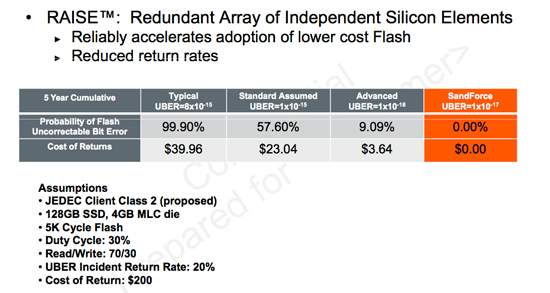OCZ's Vertex 2 Pro Preview: The Fastest MLC SSD We've Ever Tested
by Anand Lal Shimpi on December 31, 2009 12:00 AM EST- Posted in
- Storage
Controlling Costs with no DRAM and Cheaper Flash
SandForce is a chip company. They don’t make flash, they don’t make PCBs and they definitely don’t make SSDs. As such, they want the bulk of the BOM (Bill Of Materials) cost in an SSD to go to their controllers. By writing less to the flash, there’s less data to track and smaller tables to manage on the fly. The end result is SF promises its partners that they don’t need to use any external DRAMs alongside the SF-1200 or SF-1500. It helps justify SandForce’s higher controller cost than a company like Indilinx.
By writing less to flash SandForce also believes its controllers allow SSD makers to use lower grade flash. Most MLC NAND flash on the market today is built for USB sticks or CF/SD cards. These applications have very minimal write cycle requirements. Toss some of this flash into an SSD and you’ll eventually start losing data.
Intel and other top tier SSD makers tackle this issue by using only the highest grade NAND available on the market. They take it seriously because most users don’t back up and losing your primary drive, especially when it’s supposed to be on more reliable storage, can be catastrophic.
SandForce attempts to internalize the problem in hardware, again driving up the cost/value of its controller. By simply writing less to the flash, a whole new category of cheaper MLC NAND flash can be used. In order to preserve data integrity the controller writes some redundant data to the flash. SandForce calls it similar to RAID-5, although the controller doesn’t generate parity data for every bit written. Instead there’s some element of redundancy, the extent of which SF isn’t interested in delving into at this point. The redundant data is striped across all of the flash in the SSD. SandForce believes it can correct errors at as large as the block level.

There’s ECC and CRC support in the controller as well. The controller has the ability to return correct data even if it comes back with errors from the flash. Presumably it can also mark those flash locations as bad and remember not to use them in the future.

I can’t help but believe the ability to recover corrupt data, DuraWrite technology and AES-128 encryption are somehow related. If SandForce is storing some sort of hash of the majority of data on the SSD, it’s probably not too difficult to duplicate that data, and it’s probably not all that difficult to encrypt it either. By doing the DuraWrite work up front, SandForce probably gets the rest for free (or close to it).










100 Comments
View All Comments